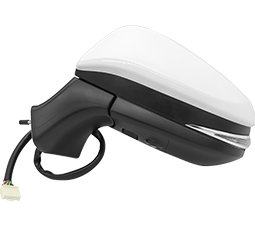2025-04-03
Reducing wind noise and air resistance through shape optimization in automotive side mirror design is a critical aspect of improving vehicle aerodynamics, fuel efficiency, and driving comfort. Below are the key principles, strategies, and methods to achieve this:
1. Understanding the Sources of Wind Noise and Air Resistance
Wind Noise : Caused by turbulent airflow, vortex formation, and flow separation around the mirror. Pressure fluctuations from these phenomena generate audible noise.
Air Resistance : The mirror's shape disrupts airflow, creating drag (measured as the drag coefficient, Cd). This impacts fuel efficiency and vehicle performance.
To address these issues, the mirror's geometry must be optimized to minimize turbulence and streamline airflow.
2. Key Principles for Shape Optimization
(1) Streamlined Design
Aerodynamic Shape : Use a teardrop or elliptical profile to reduce flow separation and turbulence. A smooth, rounded leading edge helps guide airflow smoothly over the mirror.
Tapered Trailing Edge : Gradually reduce the cross-sectional area toward the rear to minimize wake turbulence and pressure drag.
(2) Minimize Frontal Area
Reduce the mirror's exposed surface area without compromising the driver's field of view. Smaller mirrors create less drag and noise.
Optimize the mirror housing dimensions to balance functionality and aerodynamics.
(3) Smooth Surface Finish
Ensure the mirror housing has a smooth, low-friction surface to reduce skin friction drag. Avoid sharp edges, protrusions, or uneven textures.
Advanced manufacturing techniques like injection molding or polishing can achieve high surface quality.
(4) Optimized Wake Management
Add small spoilers or fins at the trailing edge to control airflow and reduce vortex formation.
Use Computational Fluid Dynamics (CFD) simulations to test and refine these features for optimal performance.
(5) Integrated Design
Consider integrating the mirror into the car door or using flush-mounted designs to reduce its impact on airflow.
Hidden or retractable mirrors can further minimize drag and noise.
3. Simulation and Experimental Validation
(1) CFD Simulations
Use CFD tools (e.g., ANSYS Fluent, STAR-CCM+) to simulate airflow around the mirror. Analyze velocity fields, pressure distributions, and turbulence intensity.
Iteratively adjust parameters like curvature, angle, and thickness to find the most aerodynamic shape.
(2) Wind Tunnel Testing
Test physical prototypes in a wind tunnel to measure drag coefficients (Cd) and noise levels.
Validate CFD results and refine the design based on experimental data.
(3) Acoustic Testing
Measure wind noise using microphone arrays or sound pressure sensors. Analyze frequency spectra to identify noise sources.
Adjust the mirror's shape or add acoustic treatments (e.g., damping materials) to reduce noise.

4. Practical Strategies for Optimization
(1) Optimal Mounting Position
Tilt the mirror slightly backward or position it closer to the window edge to reduce frontal impact.
Adjust the height to avoid excessive drag while maintaining visibility.
(2) Internal Component Layout
Internal components like motors, heating elements, and cameras can disrupt airflow. Optimize their placement and seal gaps to minimize turbulence.
Use sound-absorbing materials inside the housing to dampen resonance noise.
(3) Active Flow Control
In high-end vehicles, active flow control technologies can be employed:
Micro-jets on the mirror surface to direct airflow.
Adjustable mirror angles to dynamically optimize aerodynamics based on speed and conditions.
5. Case Study: Optimized Side Mirror Design
Here’s an example of a successful optimization process:
Leading Edge : Designed with a large radius of curvature for smooth airflow transition.
Trailing Edge : Added a small spoiler to guide airflow outward, reducing wake turbulence.
Surface Finish : High-gloss engineering plastic with UV-resistant coating.
Mounting Position : Slightly tilted backward to minimize frontal exposure.
Results :
Drag coefficient reduced by approximately 10%.
Wind noise decreased by about 5 dB.
6. Future Trends and Innovations
Camera-Based Systems : Replacing traditional mirrors with compact cameras and digital displays eliminates drag and noise entirely.
Foldable Mirrors : Retractable designs reduce drag when not in use.
Lightweight Materials : Using advanced composites (e.g., carbon fiber) reduces weight and improves aerodynamics.
Shape optimization for automotive side mirrors involves balancing aerodynamics, functionality, and aesthetics. By leveraging CFD simulations, wind tunnel testing, and innovative design strategies, manufacturers can significantly reduce wind noise and air resistance. Future advancements, such as camera-based systems and active flow control, will further enhance vehicle performance and comfort.